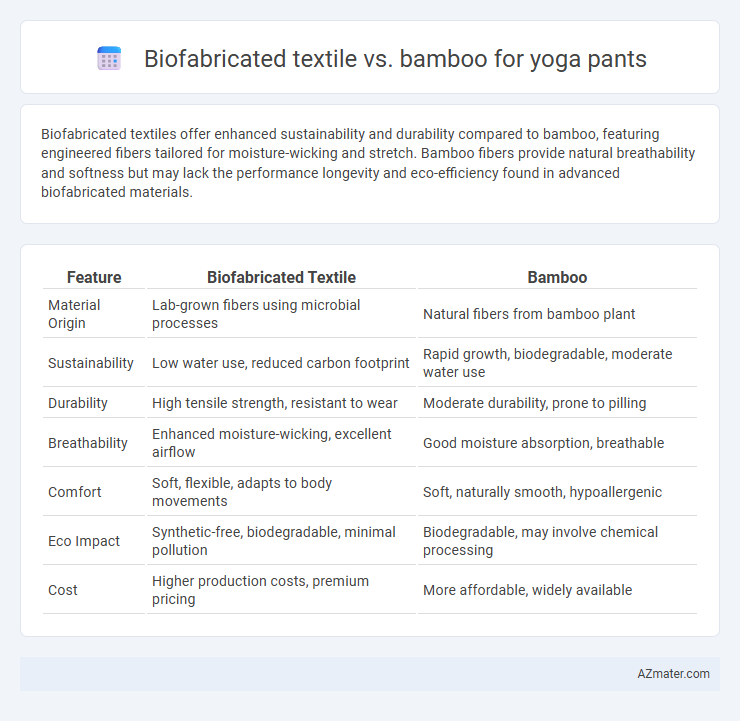Biofabricated textiles offer enhanced sustainability and durability compared to bamboo, featuring engineered fibers tailored for moisture-wicking and stretch. Bamboo fibers provide natural breathability and softness but may lack the performance longevity and eco-efficiency found in advanced biofabricated materials.
Table of Comparison
| Feature | Biofabricated Textile | Bamboo |
|---|---|---|
| Material Origin | Lab-grown fibers using microbial processes | Natural fibers from bamboo plant |
| Sustainability | Low water use, reduced carbon footprint | Rapid growth, biodegradable, moderate water use |
| Durability | High tensile strength, resistant to wear | Moderate durability, prone to pilling |
| Breathability | Enhanced moisture-wicking, excellent airflow | Good moisture absorption, breathable |
| Comfort | Soft, flexible, adapts to body movements | Soft, naturally smooth, hypoallergenic |
| Eco Impact | Synthetic-free, biodegradable, minimal pollution | Biodegradable, may involve chemical processing |
| Cost | Higher production costs, premium pricing | More affordable, widely available |
Introduction to Sustainable Yoga Pant Materials
Biofabricated textiles, engineered through lab-grown fibers, offer a cutting-edge sustainable alternative for yoga pants by reducing reliance on traditional agriculture and minimizing environmental impact. Bamboo fabric, known for its natural antimicrobial properties and biodegradability, remains a popular eco-friendly choice due to its fast-growing and renewable characteristics. Comparing these materials highlights biofabrication's potential to revolutionize sustainable activewear with enhanced durability and lower water consumption.
What Are Biofabricated Textiles?
Biofabricated textiles are materials produced through biological processes using microorganisms, cells, or enzymes rather than traditional agriculture or petrochemical methods, offering sustainable alternatives to conventional fibers. Compared to bamboo textiles, which are derived from mechanically or chemically processed bamboo plants, biofabricated textiles minimize environmental impact by reducing water use, land use, and chemical pollutants. These innovative materials provide high performance and consistency for yoga pants, combining eco-friendly production with durability and comfort.
Understanding Bamboo Fabric Production
Biofabricated textiles for yoga pants utilize lab-grown fibers engineered for durability and sustainability, minimizing environmental impact compared to traditional materials. Bamboo fabric production involves harvesting bamboo stalks, mechanically or chemically processing them into viscose or lyocell fibers, which are then spun into yarn suitable for stretchable, breathable yoga wear. Understanding the chemical treatment in bamboo fabric production highlights concerns about eco-friendliness, positioning biofabricated textiles as a cutting-edge alternative with potentially lower ecological footprints.
Environmental Impact: Biofabricated Textiles vs Bamboo
Biofabricated textiles significantly reduce environmental impact by utilizing lab-grown materials that require less water, land, and pesticides compared to traditional bamboo cultivation. Bamboo, while renewable and fast-growing, often involves intensive farming practices, chemical processing, and large water consumption that can lead to deforestation and ecosystem disruption. Choosing biofabricated textiles for yoga pants optimizes sustainability by minimizing resource use and pollution throughout the production lifecycle.
Performance and Comfort Comparison
Biofabricated textiles for yoga pants offer superior moisture-wicking, enhanced durability, and excellent breathability compared to bamboo fabrics, which provide natural softness and antimicrobial properties. The innovative fiber structure in biofabricated materials delivers better stretch recovery and shape retention, optimizing performance during intense yoga sessions. Bamboo fabrics excel in comfort with a silky feel and temperature regulation but may lack the long-term resilience and quick-drying capabilities found in biofabricated alternatives.
Durability and Longevity: Which Lasts Longer?
Biofabricated textiles, engineered from synthetic biology processes, offer superior durability and resistance to wear compared to bamboo fibers, which are naturally softer but tend to degrade faster with repeated washing. The molecular structure of biofabricated fabrics enhances tensile strength and elasticity, extending the lifespan of yoga pants significantly beyond that of bamboo counterparts. Bamboo textiles, while eco-friendly and breathable, generally show quicker signs of pilling, fading, and structural breakdown, making biofabricated textiles the longer-lasting choice for yoga apparel.
Eco-Friendly Certifications and Standards
Biofabricated textiles for yoga pants commonly feature certifications such as OEKO-TEX Standard 100 and Global Organic Textile Standard (GOTS), ensuring non-toxic materials and sustainable production processes. Bamboo fabrics often hold certifications like FSC (Forest Stewardship Council) and OEKO-TEX, highlighting responsible bamboo sourcing and chemical-free processing. Both textiles meet eco-friendly standards, but biofabricated options typically surpass in water conservation and reduced carbon emissions during manufacturing.
Ethical Considerations in Material Sourcing
Biofabricated textiles for yoga pants offer a sustainable alternative by using lab-grown fibers that eliminate reliance on traditional agriculture, reducing deforestation and water consumption. Bamboo fabric, while natural and biodegradable, often involves intensive chemical processing that raises environmental and ethical concerns such as pollution and worker safety. Choosing biofabricated textiles supports ethical material sourcing by minimizing ecological impact and promoting transparent, cruelty-free production practices.
Market Trends in Sustainable Yoga Wear
Biofabricated textiles in sustainable yoga wear are rapidly gaining traction due to their innovative, eco-friendly production methods that minimize water use and carbon emissions compared to traditional fabrics. Bamboo fabric remains popular for its natural antibacterial properties and biodegradability, but biofabricated materials offer enhanced durability and customizable performance characteristics. Market trends indicate a growing consumer preference for advanced sustainable textiles like biofabricated blends, driven by increasing environmental awareness and demand for high-performance activewear.
Choosing the Right Fabric for Yoga Pant Innovation
Biofabricated textiles offer superior sustainability and durability compared to bamboo fabrics for yoga pants, featuring engineered fibers that enhance moisture-wicking and stretchability. Bamboo fabric, known for its natural softness and antibacterial properties, remains a popular choice but often lacks the advanced performance characteristics of biofabricated alternatives. Choosing the right fabric hinges on balancing eco-friendly innovation with functional benefits such as breathability, flexibility, and long-term wear resistance.

Infographic: Biofabricated textile vs Bamboo for Yoga pant
 azmater.com
azmater.com